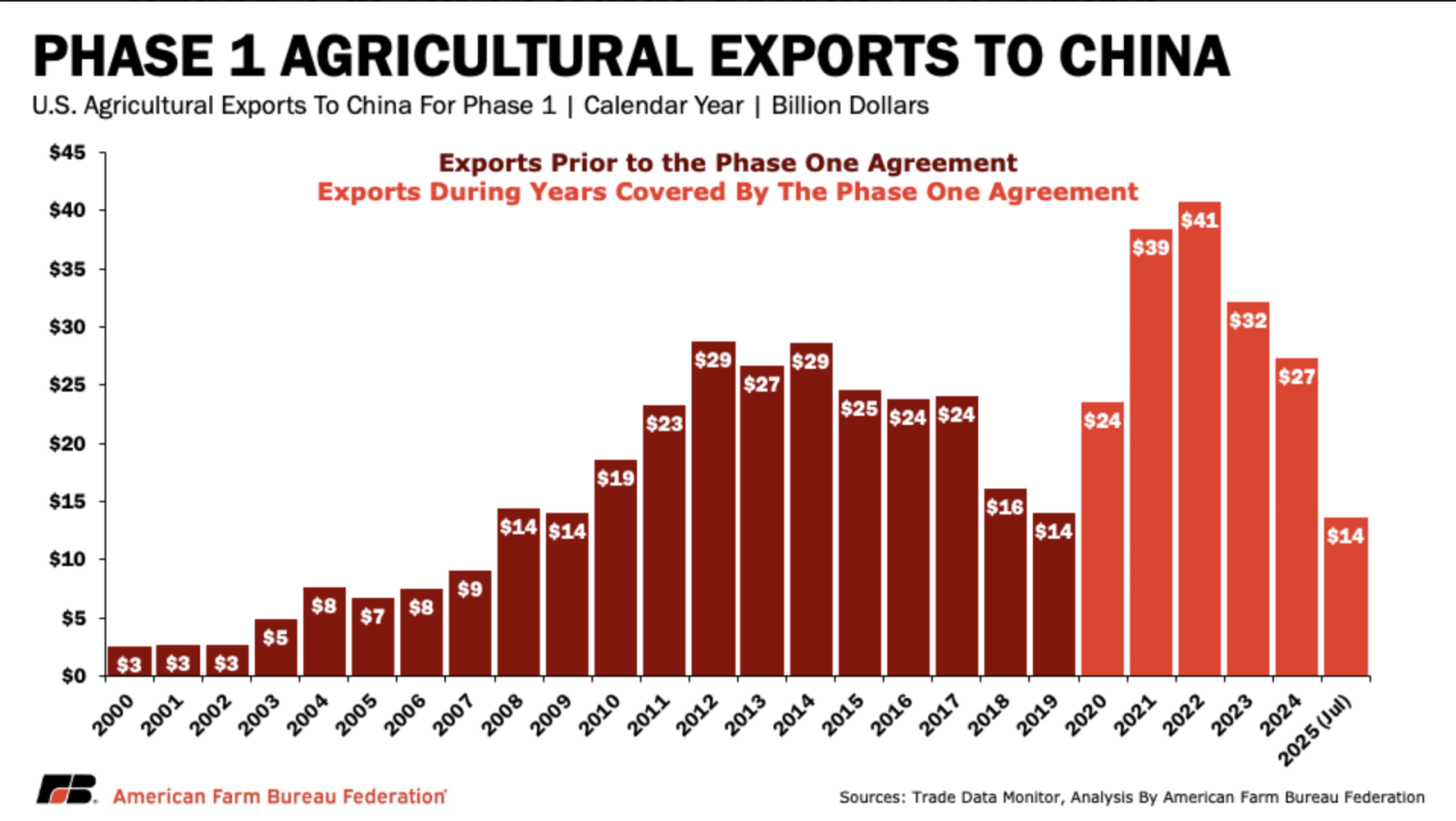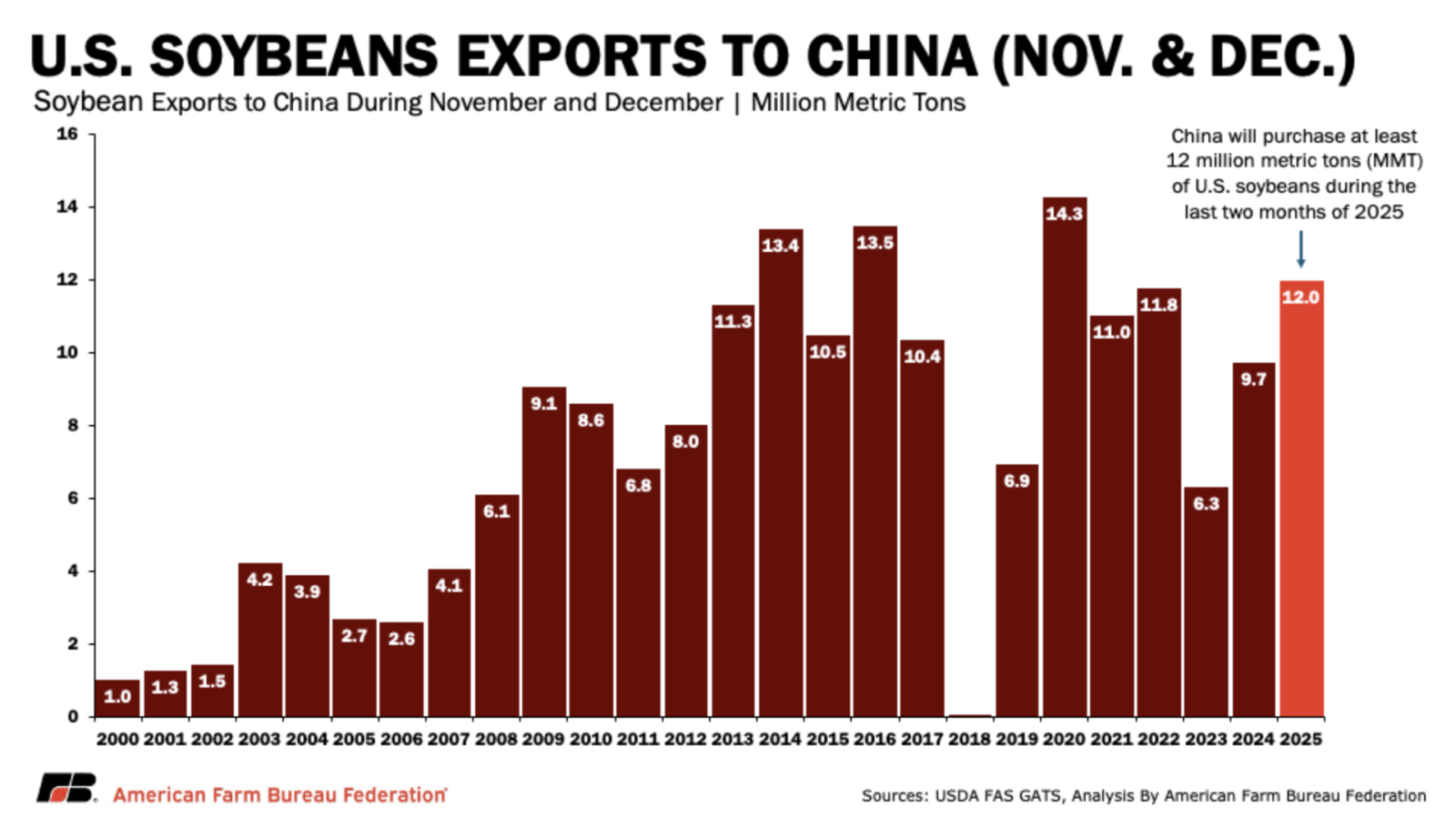Ag News
China agrees to buy 87 million metric tons of U.S. soybeans
Posted on Nov 05, 2025 at 11:54 AM
Information from AFBF Nov. 3 Market Intel
After months of negotiations with the Chinese, President Donald Trump has announced a deal on economic and trade relations with China which includes reduction in Chinese tariffs on a variety of U.S. agricultural products and a commitment to purchase a minimum of 87 million metric tons of U.S. soybeans through 2028.
The reduction of Chinese tariffs includes those on U.S.-produced chicken, wheat, corn, cotton, sorghum, soybeans, pork, beef, aquatic products, fruits, vegetables and dairy products.
The agricultural-related provisions are reminiscent of the 2020 Phase One deal with China that included agricultural purchase commitments that resulted in more than $60 billion in agricultural exports over the first two years of the deal.
China’s Historical Agricultural Purchases
Before the Phase One agreement, U.S. agricultural exports to China had grown steadily from $2.6 billion in 2000 to a then-record $28.7 billion in 2012, mirroring a broader era of export expansion that positioned China as the anchor of U.S. demand growth. During Phase One negotiations, agricultural exports to China fell sharply – as they have this year, reaching a low of $14 billion in 2019. In response to the downturn in the farm economy created by the pullback in agricultural purchases by China, the previous Trump administration provided a total of $23 billion in economic aid delivered directly to farmers and ranchers.
During the years covered by the Phase One agreement, U.S. agricultural exports to China surged to $24 billion in 2020, $39 billion in 2021 and peaked at $41 billion in 2022. During the first two years of the Phase One agreement, China purchased more than $60 billion in U.S. agricultural products. While short of the $80 billion goal, these Phase One purchases contributed significantly to an increase in crop cash receipts to a record $283 billion and a record-high U.S. net farm income in 2022 of $182 billion.
 Despite provisions that allow for consultation if the purchase commitments fall short, China gradually redirected portions of its feed, cotton and livestock imports toward alternative suppliers, and U.S. exports to China slowed, dropping to $32 billion in 2023 and $27 billion in 2024. Year-to-date, through July 2025, U.S. exports to China stand at only $14 billion, a figure expected to rise as China follows through on new purchase commitments of U.S. agricultural products.
Despite provisions that allow for consultation if the purchase commitments fall short, China gradually redirected portions of its feed, cotton and livestock imports toward alternative suppliers, and U.S. exports to China slowed, dropping to $32 billion in 2023 and $27 billion in 2024. Year-to-date, through July 2025, U.S. exports to China stand at only $14 billion, a figure expected to rise as China follows through on new purchase commitments of U.S. agricultural products.
Phase Two Soybean Commitments
As part of the recently announced deal, China will purchase at least 12 million metric tons (MMT) of U.S. soybeans during the last two months of 2025 and at least 25 MMT of U.S. soybeans each in 2026, 2027, and 2028. Additionally, China will resume purchases of sorghum and hardwood logs from the U.S., though specific quantities have not been announced.
Historically, over the last decade U.S. farmers have exported an average of more than 27 MMT of soybeans each calendar year. While the commitment to purchase 25 MMT falls slightly short of the historical average, it’s important to acknowledge that these commitments are a minimum, and not a maximum purchase amount. Exports at or above these agreed-upon quantities would represent a minimum of approximately $32 billion received by farmers based on today’s marketing year average price projection of $10 per bushel (this total would move higher as export volumes or soybean prices move higher).
 AFBF analysis indicates that the 12 MMT commitment for the rest of 2025 is a lofty but achievable goal. Over the last decade, U.S. soybean exports to China during the last 2 months of the calendar year averaged 9.5 MMT. If realized, China’s purchases of 12 MMT of soybeans in November and December of this year would be the fourth-highest export volume in history. When combined with nearly 6 MMT of soybeans already exported in calendar year 2025, total soybean purchases would approach 18 MMT, before increasing to 25 MM over the next 3 calendar years.
AFBF analysis indicates that the 12 MMT commitment for the rest of 2025 is a lofty but achievable goal. Over the last decade, U.S. soybean exports to China during the last 2 months of the calendar year averaged 9.5 MMT. If realized, China’s purchases of 12 MMT of soybeans in November and December of this year would be the fourth-highest export volume in history. When combined with nearly 6 MMT of soybeans already exported in calendar year 2025, total soybean purchases would approach 18 MMT, before increasing to 25 MM over the next 3 calendar years.

Summary
Over the course of more than two decades, China has grown into a major market for U.S. farmers and ranchers, and their participation, or lack thereof, ripples across the farm economy, reaching deep into rural communities where export strength often determines whether small towns grow or fade. Under the Phase One agreement, U.S. agricultural exports to China reached record highs and largely contributed to record-high cash receipts for crops and record-high U.S. net farm income.
The expectation in farm country is the newly announced deal on economic and trade relations with China could have a similar impact on U.S. agricultural exports and the broader U.S. farm economy. AFBF analysis indicates that while not a cure-all, especially with other priorities like year-round E-15 and fair and enforceable trade agreements in other parts of the world, China remains the 800-pound gorilla in the room that many hope will begin to turn around farm income and generate economic activity in the communities farmers and ranchers call home. Whether that hope becomes reality will depend on consistent follow-through by both parties and a geopolitical and market environment that allows the deal to endure.
- Categories:
- Tags: